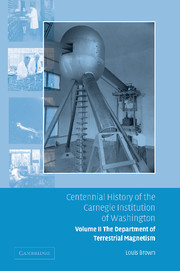Book contents
- Frontmatter
- Contents
- Foreword by Richard A. Meserve
- Preface
- 1 Establishment
- 2 Cruises and war
- 3 Expeditions
- 4 Measurements: magnetic and electric
- 5 The Fleming transition
- 6 The last cruise
- 7 The magnetic observatories and final land observations
- 8 The ionosphere
- 9 Collaboration and evaluation
- 10 The Tesla coil
- 11 The Van de Graaff accelerator
- 12 The nuclear force
- 13 Fission
- 14 Cosmic rays
- 15 The proximity fuze and the war effort
- 16 The Tuve transition
- 17 Postwar nuclear physics
- 18 The cyclotron
- 19 Biophysics
- 20 Explosion seismology
- 21 Isotope geology
- 22 Radio astronomy
- 23 Image tubes
- 24 Computers
- 25 Earthquake seismology
- 26 Strainmeters
- 27 The Bolton and Wetherill years
- 28 Astronomy
- 29 The solar system
- 30 Geochemistry
- 31 Island-arc volcanoes
- 32 Seismology revisited
- 33 Geochemistry and cosmochemistry
- 34 The Solomon transition
- 35 The support staff
- 36 Epilogue
- Notes
- Index
20 - Explosion seismology
Published online by Cambridge University Press: 06 January 2010
- Frontmatter
- Contents
- Foreword by Richard A. Meserve
- Preface
- 1 Establishment
- 2 Cruises and war
- 3 Expeditions
- 4 Measurements: magnetic and electric
- 5 The Fleming transition
- 6 The last cruise
- 7 The magnetic observatories and final land observations
- 8 The ionosphere
- 9 Collaboration and evaluation
- 10 The Tesla coil
- 11 The Van de Graaff accelerator
- 12 The nuclear force
- 13 Fission
- 14 Cosmic rays
- 15 The proximity fuze and the war effort
- 16 The Tuve transition
- 17 Postwar nuclear physics
- 18 The cyclotron
- 19 Biophysics
- 20 Explosion seismology
- 21 Isotope geology
- 22 Radio astronomy
- 23 Image tubes
- 24 Computers
- 25 Earthquake seismology
- 26 Strainmeters
- 27 The Bolton and Wetherill years
- 28 Astronomy
- 29 The solar system
- 30 Geochemistry
- 31 Island-arc volcanoes
- 32 Seismology revisited
- 33 Geochemistry and cosmochemistry
- 34 The Solomon transition
- 35 The support staff
- 36 Epilogue
- Notes
- Index
Summary
In examining the records from 29 seismic stations following a large earthquake in 1909, Andrija Mohorovicic of the University of Zagreb concluded that there was an interface approximately 50 km below the surface, above which waves traveled at 5.7 km/sec and below which at 7.8 km/sec. This discontinuity, now generally referred to as the Moho, had not had a clean verification by 1948 for a number of reasons. The observatories used for the recording of earthquakes were too few to yield data over the relatively short distances needed to show the Moho, and their recording speeds were too slow, a consequence of the need to record continuously in order to capture the randomly occurring quakes. The timing and ranging were also poor because arrival times had to be used to learn origin time, epicenter and depth of focus. Add to these problems station locations not optimum for close crustal studies and non-uniform recording instruments at the observatories, and one easily understands why nearly 40 years after its discovery, the location of the Moho was not known and the structure of the crust was a mystery.
Immediately after the war Tuve foresaw possibilities for studying the Earth's crust in an improved manner using seismic waves generated by large explosions, a method used previously to a limited degree for this purpose and for locating oil deposits, but the magnitudes of those explosions were sufficient only to examine the structure of formations a few kilometers deep.
- Type
- Chapter
- Information
- Centennial History of the Carnegie Institution of Washington , pp. 149 - 156Publisher: Cambridge University PressPrint publication year: 2005



